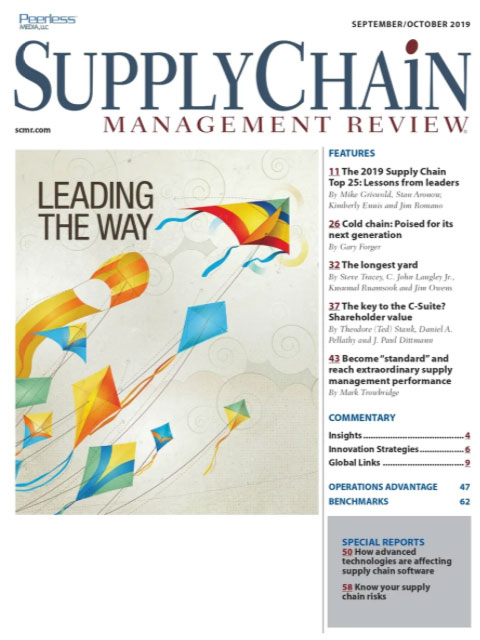Sorry, but your login has failed. Please recheck your login information and resubmit. If your subscription has expired, renew here.
September-October 2019
It’s that time of year again, when we feature the Top 25 supply chains from Gartner. What I enjoy most about this research is the window it provides into where supply chains are going next: After all, while some lead, the rest of us follow. Browse this issue archive.Need Help? Contact customer service 847-559-7581 More options
Despite significant changes to U.S. trade and tax policies, manufacturing is not returning to U.S. shores quite yet. In fact, A.T. Kearney’s 2019 Reshoring Index reveals that imports from the 14 largest low-cost countries (LCCs) in Asia have risen $66 billion—the largest annual increase since the beginning of the economic recovery in 2011. However, China is not exactly winning the war. Amid a variety of overlapping trends, the country’s share of offshoring is dwindling.
Yes, tariffs are making manufacturing in China more expensive, but the reality is that manufacturers have spent the past decade gradually shifting their operations to other LCCs, partly because of China’s escalating labor costs. Rather than incentivizing manufacturers to bring production back to the United States, the U.S. trade war with China is just accelerating the shift toward those countries.
Now in its sixth annual edition, this year’s Reshoring Index report includes a new China Diversification Index, which examines the trend of manufacturers leaning away from China. What it reveals is that although China has held on to nearly two-thirds of U.S. imports, the country’s slice of the import pie has been shrinking (see Figure 1).
If the United States and China aren’t winning, who is?
Five years ago, China had the largest share with 69% of total imports to the United States from low-cost trading partners. But by the end of 2018, its share had dropped to 65%. Add in data from 2019, and this trend is now even more pronounced as China’s share of total imports dropped to 60% during the first quarter. The rapid decline is partly the result of U.S. firms stockpiling Chinese imports last year in anticipation of planned tariff hikes, and partly because of structural shifts in manufacturers’ sourcing strategies.

This complete article is available to subscribers only.
Log in now for full access or start your PLUS+ subscription for instant access.
SC
MR
Sorry, but your login has failed. Please recheck your login information and resubmit. If your subscription has expired, renew here.
September-October 2019
It’s that time of year again, when we feature the Top 25 supply chains from Gartner. What I enjoy most about this research is the window it provides into where supply chains are going next: After all, while some… Browse this issue archive. Access your online digital edition. Download a PDF file of the September-October 2019 issue.Despite significant changes to U.S. trade and tax policies, manufacturing is not returning to U.S. shores quite yet. In fact, A.T. Kearney's 2019 Reshoring Index reveals that imports from the 14 largest low-cost countries (LCCs) in Asia have risen $66 billion—the largest annual increase since the beginning of the economic recovery in 2011. However, China is not exactly winning the war. Amid a variety of overlapping trends, the country's share of offshoring is dwindling.
Yes, tariffs are making manufacturing in China more expensive, but the reality is that manufacturers have spent the past decade gradually shifting their operations to other LCCs, partly because of China's escalating labor costs. Rather than incentivizing manufacturers to bring production back to the United States, the U.S. trade war with China is just accelerating the shift toward those countries.
Now in its sixth annual edition, this year's Reshoring Index report includes a new China Diversification Index, which examines the trend of manufacturers leaning away from China. What it reveals is that although China has held on to nearly two-thirds of U.S. imports, the country's slice of the import pie has been shrinking (see Figure 1).
If the United States and China aren't winning, who is?
Five years ago, China had the largest share with 69% of total imports to the United States from low-cost trading partners. But by the end of 2018, its share had dropped to 65%. Add in data from 2019, and this trend is now even more pronounced as China's share of total imports dropped to 60% during the first quarter. The rapid decline is partly the result of U.S. firms stockpiling Chinese imports last year in anticipation of planned tariff hikes, and partly because of structural shifts in manufacturers' sourcing strategies.
SC
MR


Latest Supply Chain News
- 6 Questions With … Sandeep Bhide
- MIT CTL offering humanitarian logistics course
- Bridging the ESG gap in supply chain management: From ambition to action
- Few executives believe their supply chains can respond quickly to disruptions
- Technology’s role in mending supply chain fragility after recent disruptions
- More News
Latest Podcast

 Explore
Explore
Procurement & Sourcing News
- Bridging the ESG gap in supply chain management: From ambition to action
- Israel, Ukraine aid package to increase pressure on aerospace and defense supply chains
- How CPG brands can deliver on supplier diversity promises
- How S&OP provides the answer to in-demand products
- There is still work to do to achieve supply chain stability
- Blooming success: The vital role of S&OE in nurturing global supply chains
- More Procurement & Sourcing
Latest Procurement & Sourcing Resources

Subscribe

Supply Chain Management Review delivers the best industry content.

Editors’ Picks






